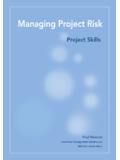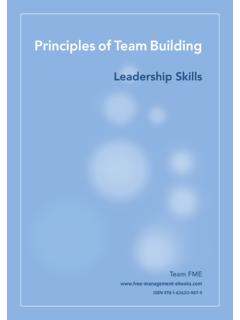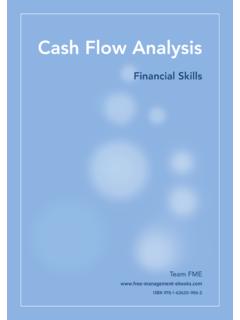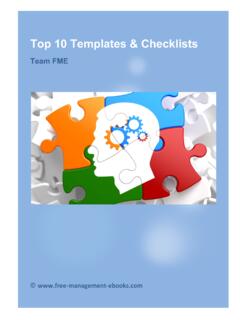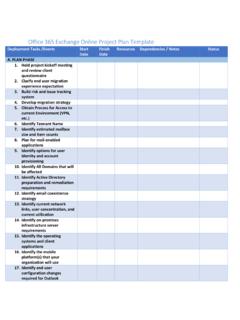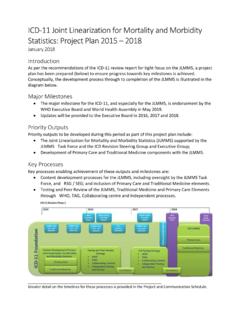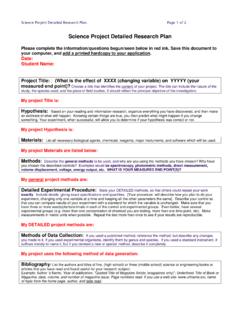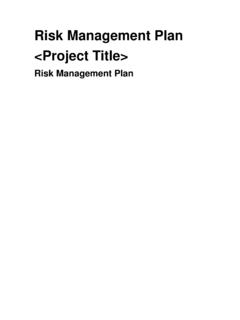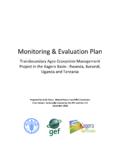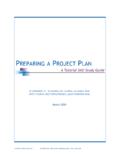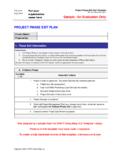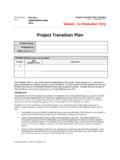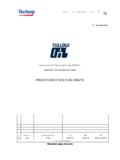Transcription of PROJECT MANAGEMENT PLAN CHECKLIST - …
1 All Rights Reserved PROJECT MANAGEMENT plan CHECKLIST The PROJECT MANAGEMENT plan is a comprehensive document that defines each area of your PROJECT . The final document will contain all the required plans you need to manage, monitor and implement your PROJECT . Your plan must also describe the deliverables and benefits it brings to the organization. The introduction to the plan provides a high-level framework and summary of the PROJECT objective. The remainder of the plan is made up of a series of plans that are applicable to each functional area. For example: PROJECT Team MANAGEMENT (Human Resources) Scope Schedule (Timeframe & Milestones) Budget Quality Risk Communications Contract & Supplier MANAGEMENT In the case of smaller projects, this plan can serve as a self-contained planning document.
2 However, in larger projects it makes more sense to create a series of subordinate plans for each functional area (scope, budget, schedule, risk, quality, human resources, etc). Using the PROJECT plan as a parent plan that refers to these subordinate plans prevents it from becoming too lengthy and complex. The following outline provides a good foundation for a PROJECT MANAGEMENT plan but you will need to use your own judgment about which sections to use and how much detail to go into. PROJECT MANAGEMENT plan CHECKLIST All Rights Reserved PROJECT MANAGEMENT plan CHECKLIST All Rights Reserved MANAGEMENT SUMMARY This section should explain the business background to the PROJECT , what the PROJECT hopes to achieve and what the intended outcome will look like.
3 This information should already exist in the business case, PROJECT charter and the preliminary scope statement. It is important that PROJECT objectives are stated in a clear and measurable way so that when the PROJECT is completed there can be no argument about whether or not it has achieved these stated objectives. Many projects fail because the objectives are not measurable and the language used to describe them means different things to different stakeholders. For example, the objective: Resolve 75% of billing queries during first customer call - is clear and measurable, whereas, Improve how customer billing queries are handled - is not. The objectives must be clear enough so that the PROJECT can be measured against them once completed. Most of this information should already exist in the business case, PROJECT charter and the preliminary scope statement.
4 The purpose of this plan should be to describe how and when a PROJECT 's objectives are to be achieved, by showing the major products, milestones, activities and resources required on the PROJECT . It should also document PROJECT team roles and responsibilities, and the governance structure of the PROJECT . These are the products and services that the PROJECT will deliver rather than the PROJECT MANAGEMENT deliverables (other plans and documents), which are detailed below. This information should already exist in the business case, PROJECT charter and the preliminary scope statement. PROJECT MANAGEMENT plan CHECKLIST All Rights Reserved HUMAN RESOURCES (HR) MANAGEMENT This section defines the people that make up the PROJECT team, both in terms of skills and knowledge.
5 The composition of the whole PROJECT team will change over the length of the PROJECT as resources alter to match the PROJECT phase. But it is important to have core of individuals that are committed throughout the PROJECT and have the correct level of MANAGEMENT , planning, organizing, monitoring and communications skills. This section needs to consider the following: Developing the HR plan is where you define the type of skills and knowledge you require for your PROJECT team members and represent this in a PROJECT organization chart. The PROJECT activities will provide you with a list of the necessary skills and level of responsibility you need for each phase or work package of the PROJECT . It will also identify if there are any training requirements and create a timetables of when, who and how long an individual will be released to the PROJECT time.
6 Acquiring PROJECT Team identifies the manner in which you will acquire the necessary individuals for the PROJECT in a timely fashion. Where specialist resources are required the PROJECT manager will negotiate the release of such individuals with their functional managers or liaise with agencies to provide people to interview in advance. Developing and Managing the PROJECT Team this is the process where the PROJECT manger builds a competent team, one that is based on trust, open and honest communications. The PROJECT manager must create an environment that encourages a collaborative way to solve problems and make decisions. Conflicts and differences of opinion will occur throughout the PROJECT and it is essential that the PROJECT manager deals with these instance in a constructive and objective manner.
7 PROJECT MANAGEMENT plan CHECKLIST All Rights Reserved COMMUNICATIONS MANAGEMENT The need for good and appropriate communications between the PROJECT manager and PROJECT stakeholders is critical for the success of any PROJECT . Understanding the importance and influence of each stakeholder enables you to define the appropriate depth and frequency of communication you have with that person throughout the PROJECT . This section defines the lines of communication and the methods to be used. In other words what should be communicated, and to whom. This may seem unnecessary during the planning phase of a PROJECT but focusing on the importance of communication at this stage will eradicate serious problems later on that could result from too much or too little communication.
8 The ease of sending emails and attached documents means that that there is a real risk of over-communication. This results in team members becoming snowed under with largely irrelevant emails. To avoid this, the ultimate goal of communications MANAGEMENT is to ensure that stakeholders receive the information they need to know at the appropriate time and at the appropriate level of detail. This section should identify what they each role is responsible for communicating, how often they need to communicate, what communication tool and medium to use and any specific triggers for communication. This section needs to consider the following: Planning Communications details the communications the PROJECT manger will have with each stakeholder and within the PROJECT team.
9 This needs to include the format (email, memo, etc), level of detail, urgency and content for each communication along with a defined frequency. Within any PROJECT there is a continual need to keep everyone involved updated, so different individuals will be responsible for certain types of communication. Distributing Information this describes how you will actually distribute information appropriately to interested parties during the PROJECT . This can take many forms, email, phone, text, web conferences, intranet, presentations, reports etc. PROJECT MANAGEMENT plan CHECKLIST All Rights Reserved COMMUNICATIONS MANAGEMENT CONTINUED Managing Stakeholder Expectations having a clear understanding of your stakeholders expectations will enable the PROJECT manager to communicate with each in a way that addresses their concerns and interests when wanting to resolve issues.
10 There are certain documents that any alterations to the PROJECT need to be recorded in to ensure your stakeholders are up-to-date. These are the stakeholder register, issue log and if appropriate the stakeholder MANAGEMENT strategy. Reporting Performance this section defines the style of reporting to be used, often this is a simple traffic light system to report the status of different activities or work packages. Stakeholders are usually most interested in how actual events compare to the forecast and the Earned Value method (EVM) is a popular way to do this. PROJECT MANAGEMENT plan CHECKLIST All Rights Reserved SCOPE MANAGEMENT Many PROJECT mangers use the PROJECT charter scope statement as a basis for this section, which must define, communicate and gain agreement on the exact details of the PROJECT .
